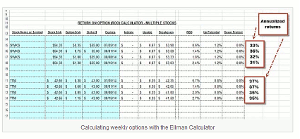Alan Ellman of TheBlueCollarInvestor.com outlines weekly stock options and looks at the pros and cons in relation to one, two, three, and four-week options.
With the rising popularity of stock option strategies and covered call writing in particular, we have seen the creation of more option products like weekly stock options. Weeklys expire each Friday of the month whereas the more traditional monthlys generally expire only on the third Friday of each month. Weeklys fall into one of two categories: standard weeklys or expanded weeklys. In the last quarter of 2012, the options exchanges received regulatory approval for extended Weekly expirations. The options exchanges can now list up to five consecutive Weekly expirations for selected securities. Although any product with Weekly expirations can be part of the extended Weekly program, the exchanges will typically select the most actively traded options.
If the regular monthly expiration is three weeks away, then investors would most likely see Weekly, Weekly, Monthly, Weekly and Weekly expirations listed over a five-week period. There are no new Weeklys added that would expire during the expiration week for traditional monthlys, which is typically the third Friday of each month, nor are they even listed if they would expire on the same date as a Quarterly option on the same underlying security. Quarterlys are options that expire at the ends of quarters.
With so many more choices than we previously had available, I thought it would be interesting to evaluate the returns for one, two, three, and four-week options on the same underlying securities and then annualize those returns to give us a sense as to which timeframe may be in our best interest. Although this is far from a long-term scientific study, I did find the results interesting as a preliminary view into the world of weekly stock options. Here’s how I set things up:
Evaluation setup
I selected two stocks from our Premium Stock Report dated July 18, 2014.
- These stocks had to have expanded weeklys associated with them.
- Neither stock could have an upcoming earnings report prior to expiration.
- Data was taken immediately after expiration of the July contracts.
- One, two, three, and four-week options were calculated.
- The two stocks selected were (SWKS) and (TTM).
Calculating results
Here are the results as shown in the “multiple tab” of the Ellman Calculator:
Summary of results
- The options in weeks one and two showed slightly higher returns than those in weeks three and four for both stocks.
- Is this small difference enough for us to favor weeklys over the more traditional monthlys?
In my humble opinion
From this initial, admittedly cursory, view of weekly calculations there appears to be no clear reason for favoring weeklys or monthlys based on annualized returns although the weeklys in weeks 1 and 2 did slightly outperform. Therefore, I would make a decision based on an overview of the pros and cons of weeklys as compared to traditional monthlys.
Pros and cons of weeklys:
Positives:
- Annualized returns can be higher.
- Can avoid exposure over weekends.
- Can generate greater premium as earnings report dates are approached and trade up to the week before earnings.
Negatives:
- The pool of stocks with weeklys is much smaller than those with monthlys.
- Management is much more time-consuming as “rolling” possibilities come up every week.
- Less time for exit strategy execution.
- Quadruple the number and amount of trading commissions.
- Lower option liquidity.
- Wider bid-ask spreads.
Conclusion
There are many ways to make money in the stock market and using weeklys is certainly one of them. There is no one strategy appropriate for every single investor so when deciding between weeklys and monthlys we must make sure we understand all the nuances (pro and con) associated with each choice to come to the conclusion that is in our personal best interest.
By Alan Ellman of TheBlueCollarInvestor.com






















